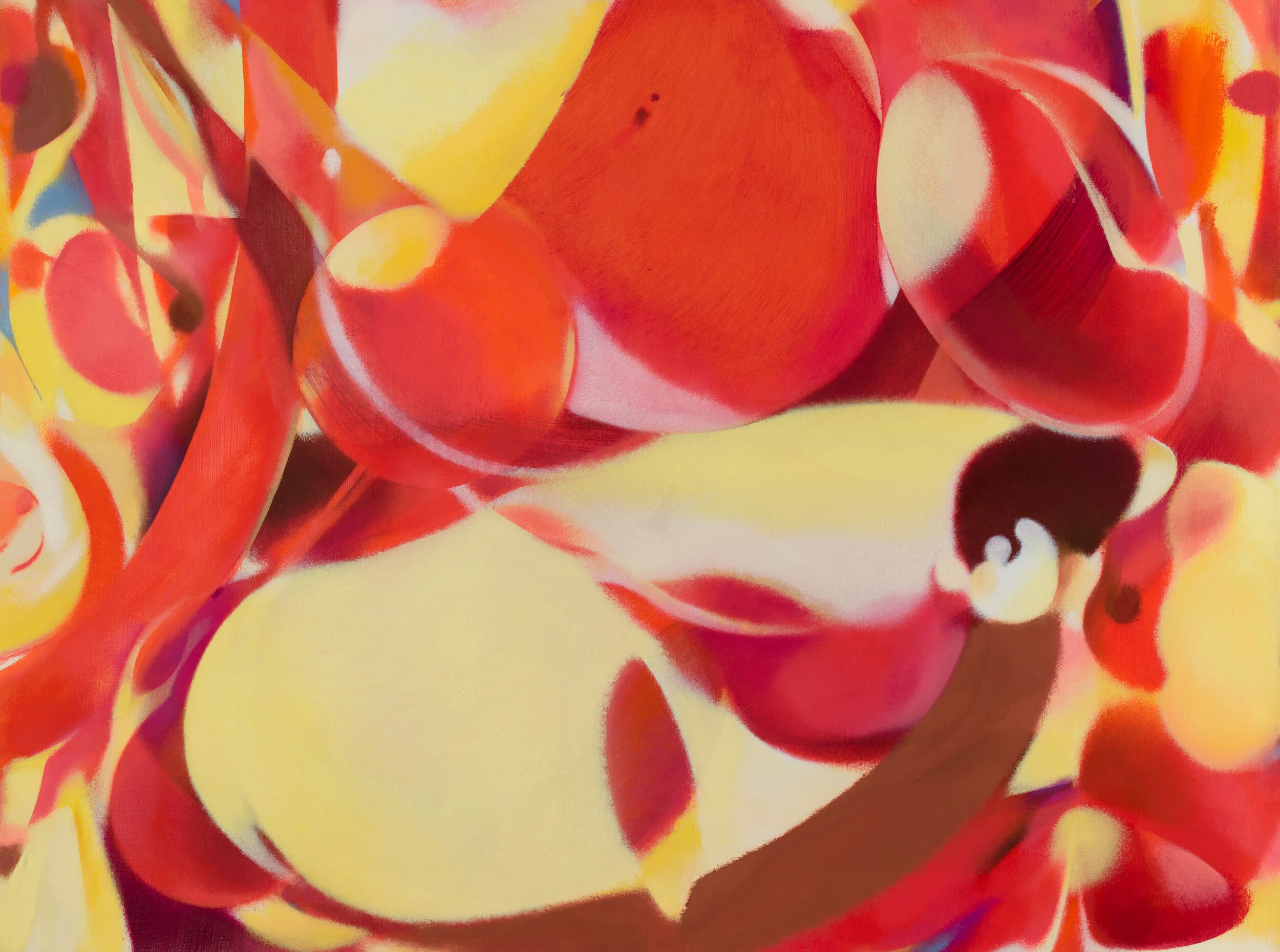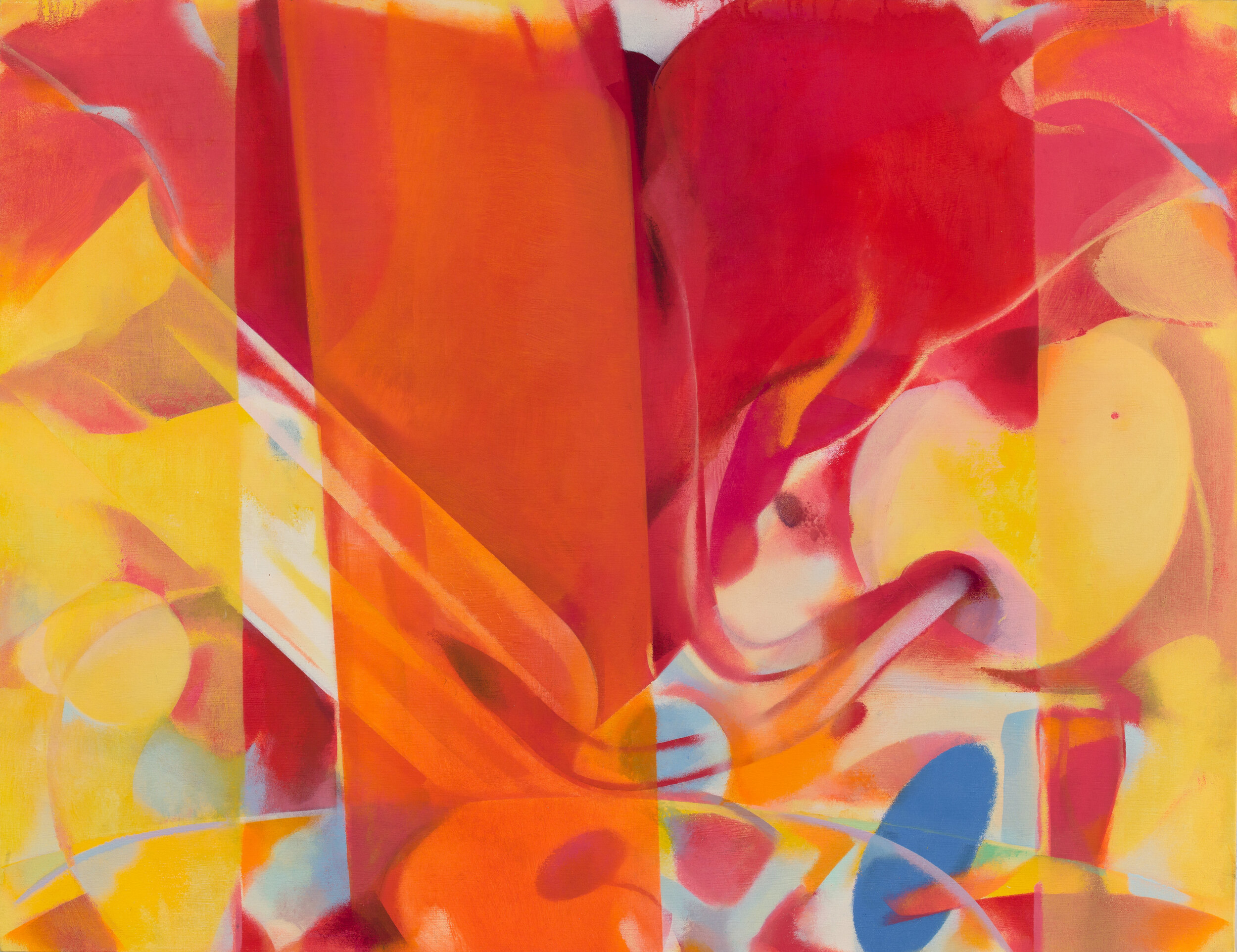Frank Mann
USA
Consider the loose circular structures that organize Mann’s new series Oculus. The circle, an image of history, decrees the natural dynamism and circularity of living life. Mann infuses this form of life with bright reds, blues and yellows equally suggestive of the eyes implied by the title, the sun and the constellation of the planets, as well as abstract thought processes. Yet and still, these are vehemently proud abstract paintings in the realm of Rothko, De Kooning, and Marden. Mann’s work holds its own in this company with his unique brand of drawing with color to convey voluminous light and deployment of forms that provoke a multitude of valid associations. The repetition of circles in Mann’s process and the material engagement with paint applied to canvas has become a poetic language occupying the energy of life made visible. His paintings are the structural signs of energy, and in that mode, they work as gorgeous signs of drama played out by color and shape evocative of art’s vast and revelatory power for the possibility of transcendental experience. As Mark Rothko once said, “I do not believe that there was ever a question of being abstract or representational. It is really a matter of ending this silence and solitude, of breathing and stretching one’s arms again.” Mann’s paintings do just that.
Franklin Sirmans, Curator of Contemporary Art, Los Angeles County Museum of Art.
Oculus, No.17
1. What’s your background?
Following many years of formal education, I began the study of human vision and perception beginning with Hasan Ibn al-Haytham and extending through the history of the science of seeing. I was greatly influenced by an early interest in science which led me to place nature at the center of my artistic endeavors, while it was through the language of painting that I came to experience directly the interaction between myself and nature. I consider the work to be informed by my own thoughts about what are the facts of vision.
2. What does your work aim to say?
Most of the paintings are an extension of my interest in vision and visual phenomena. The most recent group is titled the Oculus cycle. Oculus is, simply, the Latin word that refers to the eye. It is also the name for the tip of the dome of the Pantheon in Rome and it is also a term used to describe other architectural elements that emit light, including round windows, openings, and skylights. Most of the work derives from an internal model rather than from a description of objects in nature or a virtual scene, it derives from the imagination. And the search here is primarily for visual language, and thus, to create images that I have not seen. The method requires a willingness to embrace that which is revealed through working. Ludwig Wittgenstein once stated that “to imagine a language is to imagine a form of life.” I primarily think of painting as a field in which I am free to have ideas that I have or have not had before. Ultimately, the paintings explore the relation between the mystery of the experience of seeing and pictorial art, by visualizing the processes of seeing and externalizing that image in a concrete way, to make it more real or tangible. I wish to represent vision only as it might be.
3. How does your work comment on current social or political issues?
Eschewing esthetics for a more direct experience, I have maintained a passionate interest in the experiential and visual phenomena and it is this experience that has yielded work that is decidedly essentialist. Ultimately, I see it as interpretive, so that the imagination is a primary element. It is not about a particular vision and it is not about what I see at a particular moment. The works address a more universal experience that may be considered humanistic rather than social or political content that seeks specificity. The approach to form is a codified context of my own vocabulary which breaks the boundaries of image pushing toward a more universal wisdom. After a long period of working, the search here is primarily for visual language, and thus, to create images that I have not seen, using procedures, which through experience, give freedom to the course of the imagination.
4. Who are your biggest influences?
There have been many artists who have influenced me in the course of my development. The decision to not work with known images or directly from nature (representation) is central and the focus of my abilities on a process that featured working from 'the inside out' rather than from 'the outside in' as working from the visible world requires. These ideas regarding process seemed to me to be more authentic, and indeed, this way of working seemed more in agreement with works of art that I felt some connection to. As a mature artist, I think one is drawn to and resonates more to those artists whom you sense may have a similar working process. I was recently struck by a comment by the author Lynn Gamwell who suggested in her book, Exploring the Invisible, in regard to the painting of Paul Cezanne, "he rendered his subjective perception of the structure of the natural world”.
Oculus, No.28
5. How has your art evolved over the years?
The paintings are an extension of my interest in vision and visual perception. The six major groups of work completed to date have been produced with these themes in mind. The individual nature of each group presents a shift in the emphasis and focus on perception in the context of painting. The five previous groups include Perceptual Fields, structuring large full surfaces in low relief utilizing afterimages and illusion; Prisoner's Cinema, the sometimes hallucinatory images seen in spaces of prolonged darkness; Second Nature, works with a more figural turn with an emphasis on the nexus of languages; Shape of Vision, personal intuited images that feature a process of working from the inside out; and the Icon series, based on the iconic replica, the tiny inverted image in the back of the retina, a phase in the process of seeing. The most recent group completed is titled the Oculus cycle. Through this journey I have gone from a deeply embedded surface to one of painterly flatness, reversing a process of working from "the outside in" to "the inside out" ultimately achieving some sort of balance between inside and outside, and to painted objects of a greater depth and complexity.
6. What does art mean to you?
I have maintained a passionate interest in the experiential and in visual phenomena. I do believe that the recognition of the value of art, of what art is, is linked to one’s experience of perception that goes to the heart of extracting meaning from an image. Art can put you in touch with, for want of a better term, your higher power or self. And that these objects of our passion are the means by which we judge a civilization. The conscious effort to keep art at the center of my life performs a vital function of extending my perception. As John Dewey once observed, “Art is the living and concrete proof that man is capable of restoring consciously, and thus on the plane of meaning, the union of sense, need, impulse, and action characteristic of the live creature”.
7. What’s the most valuable piece of art to you?
As I tend to view each particular work of art that I create as an approximation, the work that most clearly reflects the clarity within the process in the final object is naturally to me of the greatest interest. No summary statements are available to me here, I can only construct the syntax, the method for each particular work that is created in that moment. Oculus, the title of the most recent works is also the Latin word for the eye, but it also refers to the name for the tip of the dome of the Pantheon in Rome. This pagan temple of 2nd Century Rome is among my favorite works of architecture, and as such, one of my favorite works of art. It encompasses a voluminous space penetrated by light, exquisite proportions of the architecture of ancient Rome and a unique relation of interior dome to temple floor. The dimensions to scale of the opening of this extraordinary dome are affixed with tape to the ceiling of my own studio in New York City to this day.
8. What’s next for you in the future?
While the work has been exhibited on six continents to date, it is most frequently exhibited in the United States and in Europe. In the coming year, exhibitions are scheduled for Artifact Gallery, New York and at the Borgo Galleria, in Rome. Work can be seen at Allesandro Berni Gallery and Ceres Gallery, both in New York, and at Colorida Galerie in Lisbon and others. I plan to exhibit in Venice during the 59th edition of the Venice Biennale in 2022. On the web, key works may be found at www.oculusonline.net as well as the various links and we are launching a newly reconstituted website at www.frankmann.com
Red Oculus



